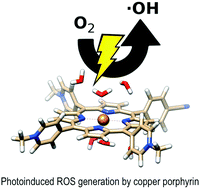Photosensitization mechanism of Cu(ii) porphyrins†
Abstract
This work presents the mechanism of the photoinduced generation of reactive oxygen species (ROS) by paramagnetic copper porphyrins in aqueous solution. Electronic structure calculations within the framework of the (time-dependent) density functional theory, (TD)DFT, reveal the details regarding the development of the atomistic and electronic structures of the copper porphyrin in solution along the set of chemical reactions accessible upon photoactivation. This study identifies the key parameters controlling the feasibility of the various reaction pathways that drive the formation of specific reactive oxygen species, ROS, i.e. superoxide, peroxyl and hydroxyl radicals. An important outcome of our results is the rationalization of how the water solvent molecules play a crucial role in most steps of the overall reaction. The present study is illustrated by focusing on one specific copper porphyrin for which precise experimental data have recently been measured, and can readily be generalized to the whole family of paramagnetic porphyrins. The conclusions of this work shed light on the rational design of metalloporphyrins as photosensitizers for photodynamic therapy.



 Please wait while we load your content...
Please wait while we load your content...